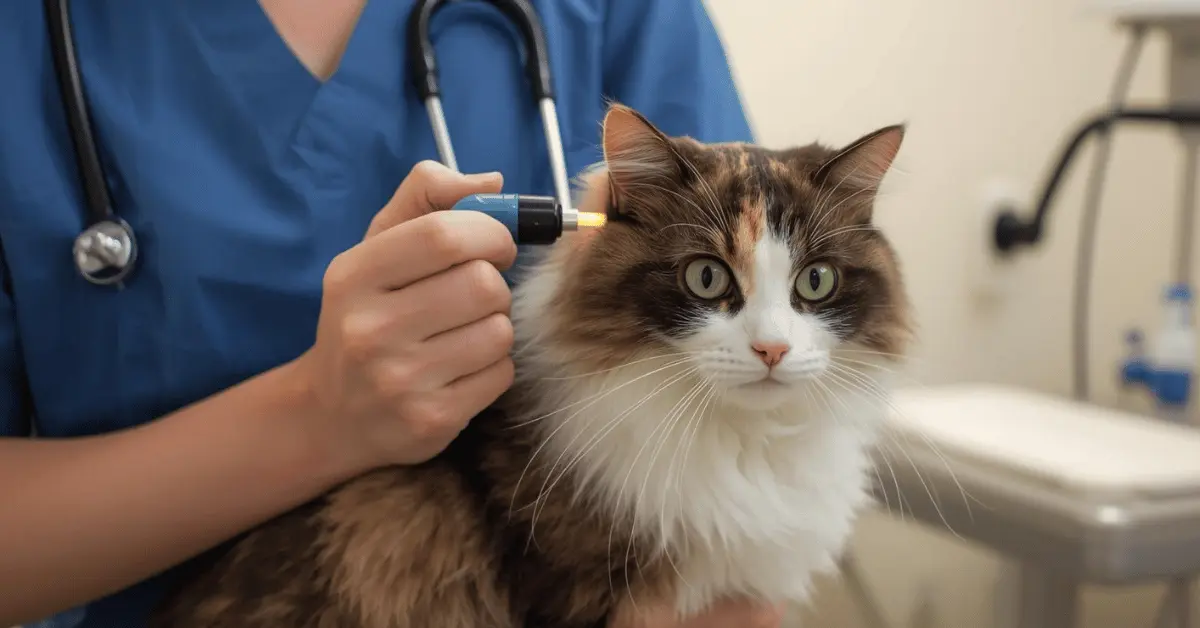Ear mites are one of the most common problems affecting cats, and if left untreated, they can cause intense itching, infections, and even hearing loss. While these tiny parasites may seem like a minor issue at first, they can quickly become a serious concern for both your cat’s comfort and long-term health.
Understanding Ear Mites in Cats
Before diving into treatment, it’s important to understand what ear mites are and why they can wreak havoc in your cat’s ears.
What Exactly Are Ear Mites?
Ear mites (Otodectes cynotis) are microscopic parasites that live in the ear canal, feeding on wax and skin oils. They are highly contagious, spreading easily between cats and sometimes even to dogs. Outdoor cats and multi-pet households are especially at risk.
Why Ear Mites Are Dangerous if Untreated
Though tiny, ear mites can cause major discomfort. Constant scratching and shaking can lead to secondary infections, swollen ear canals, and, in severe cases, permanent damage to the eardrum.
Spotting the First Symptoms of Ear Mites
The earlier you recognize ear mites, the easier it is to treat them.
Visible Signs in Your Cat’s Ears
- Dark, coffee-ground-like discharge inside the ear
- Frequent scratching of the ears and head
- Redness, swelling, or scabs around the ear canal
- Constant head shaking
These visible symptoms are usually the first red flags for most cat owners.
Subtle Behavioural Clues Owners Often Miss
Sometimes the signs aren’t so obvious. Cats with ear mites may become irritable, avoid being touched near their head, or change their sleeping habits. These subtle shifts can be easy to miss — which is why we’ll dive deeper into them in our Detailed Guide on Subtle Cat Ear Mite Symptoms.
Getting a Proper Diagnosis

Because ear mites can resemble other ear problems, getting a professional diagnosis is essential.
Vet Examination and Tests
At the vet’s office, an ear swab is usually taken and examined under a microscope to confirm the presence of mites. In some cases, your vet may use an otoscope to look directly into the ear canal.
Why You Shouldn’t Skip the Vet Visit
Some ear conditions — like yeast infections, bacterial infections, or allergies — mimic the symptoms of ear mites. Without a vet’s confirmation, you risk treating the wrong issue, which can worsen your cat’s discomfort.
Proven Treatment Options for Cat Ear Mites
Once diagnosed, your vet will recommend treatment based on the severity of the infestation.
Prescription Medications from Vets
Vet-prescribed treatments are the gold standard for eliminating ear mites. Options may include:
- Topical spot-on treatments that kill mites and sometimes also protect against fleas and ticks.
- Ear drops that target mites directly within the canal.
- Oral medications in severe cases.
For a deeper look at how these compare with store-bought options, check out our Vet vs. Pet Store Remedies Guide.
Over-the-Counter Remedies and Their Limits
Pet stores often sell ear mite treatments, but these are typically less potent than veterinary medications. While they may provide temporary relief, they rarely eliminate the infestation fully, which can lead to recurring problems.
Natural Remedies vs. Myths
It’s tempting to reach for quick home remedies you might read about online, but not all of them are safe — or effective.
Common Myths That Don’t Work
- Olive oil or baby oil: May smother mites temporarily but rarely kill all stages.
- Vinegar: Too harsh for delicate ear tissue and can cause burns.
- Hydrogen peroxide: Irritates the ear canal and can worsen infections.
Safe Alternatives You Can Discuss with Your Vet
Some natural oils and supportive remedies may help reduce irritation — but they should never replace proven medical treatments. Always consult your vet before trying any DIY approaches.
Home Care and Support During Treatment
Medication alone isn’t always enough — proper home care speeds up healing and prevents reinfestation.
Cleaning Your Cat’s Ears Safely
Using a vet-approved ear-cleaning solution helps remove debris and makes treatments more effective. Avoid harsh DIY remedies that may damage sensitive tissue.
Comfort and Environment Tips
- Wash bedding and toys to remove lingering mites.
- Keep your cat calm to reduce scratching and irritation.
- If you have multiple pets, treat them all to prevent reinfection.
For more detailed at-home strategies, see our Guide to Treating Cat Ear Mites at Home.
The Cost of Treating Ear Mites in Cats

Treatment isn’t just about time and care — there’s also a financial side to consider.
Typical Vet Visit and Medication Costs
- Vet exam: $50–$150 depending on your area.
- Prescription treatments: Usually $20–$60 per course.
- Follow-up visits: Sometimes required to confirm the mites are completely gone.
Long-Term Savings Through Prevention
Preventive care — like flea treatments that also target mites, regular ear checks, and isolating new pets until cleared — costs far less than repeated vet visits and treatment for chronic infections.
Tracking Recovery and Preventing Recurrence
Ear mite recovery doesn’t happen overnight — but consistent care ensures long-term results.
Follow-Up Care with Your Vet
Most cats start improving within a week, but follow-up appointments are crucial to confirm that the mites are completely gone. Your vet may recommend a repeat dose of treatment to ensure no eggs or larvae remain.
Preventing Future Infestations
Simple steps can keep mites from coming back:
- Regular ear checks, especially for outdoor cats.
- Routine cleaning with vet-approved solutions.
- Isolating new pets until they’re examined by a vet.
When to Worry: Complications to Watch For
While most cats recover fully, untreated or severe infestations can lead to complications such as:
- Chronic ear infections
- Thickened ear canals
- Hearing damage
If your cat’s symptoms aren’t improving with treatment, it’s time to revisit your vet. For pet owners looking for faster solutions, check our article on What Really Kills Ear Mites Instantly.
Frequently Asked Questions
How long does it take to get rid of ear mites in cats?
With prescription treatments, most cats start improving within 3–7 days. However, full recovery can take 2–3 weeks, depending on the severity of the infestation and whether secondary infections are present.
Can ear mites go away on their own?
No. Ear mites do not go away without treatment. In fact, they will continue to reproduce and cause more irritation, which can lead to infections and long-term ear damage.
Are ear mites in cats contagious to humans?
Fortunately, ear mites in cats are not usually contagious to humans, but they can easily spread to other pets, especially dogs and ferrets.
Can indoor cats get ear mites?
Yes. Even indoor cats can get ear mites — especially if they live with other pets or come into contact with contaminated bedding, toys, or carriers.

4 thoughts on “Ear Mite Treatment for Cats: From First Symptoms to Full Recovery”